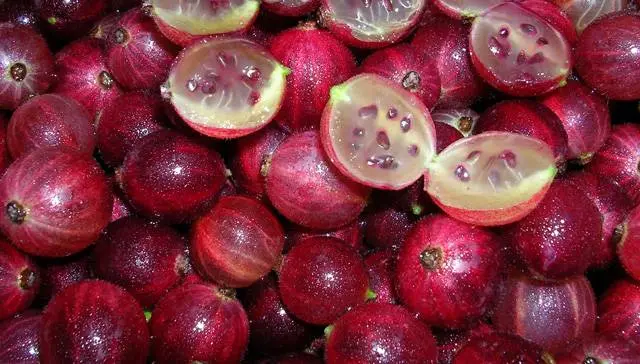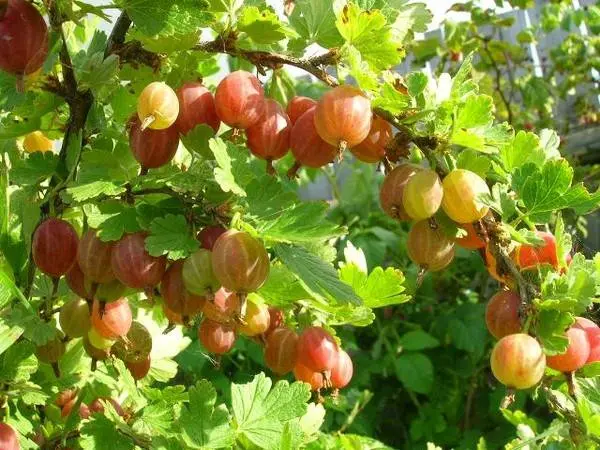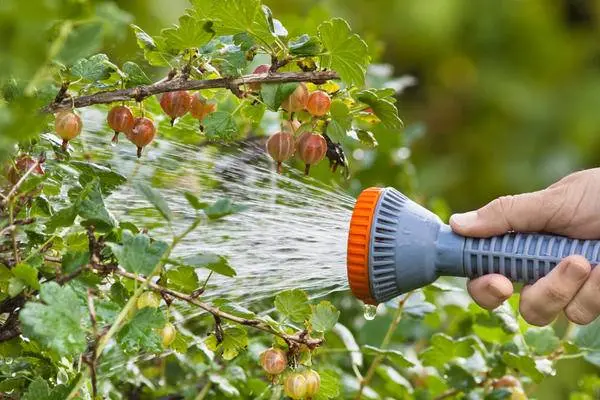Contents
One of the relatively new gooseberry varieties – Candy – is resistant to drought and low temperatures. This name was entered into the State Register in 2008. With proper care, the bush can produce about 6 kg of berries per year. It is recommended to grow candy gooseberries in eastern and western Siberia.

Features of the development of shrubs
Before you decide to purchase a gooseberry bush for your garden, you should read its description. Variety Candy is a plant of medium height, erect and dense. Dark brown buds appear on shoots. The bush cannot be called thornless, rare thorns are on the lower branches.
General characteristics of the variety
Gooseberry Candy is resistant to low temperatures. From a bush about 1 meter high, you can expect from 2 to 6,5 kg of crop, so the variety is high-yielding. Gooseberries begin to bear fruit in the second year after planting.
Variety Candy is quite demanding on the composition of the soil. According to the descriptions, loam enriched with vitamins is suitable for planting it. Sandy and sandy loamy soils will not be able to provide the plant with the necessary nutrients due to its superficial root system. The most significant part of the root is at a depth of up to 30 centimeters.

The description of the variety can be reflected in the following list:
- The ripening period is medium.
- The shrub is medium in size, with a small crown and thin branches.
- Thorns are thin, present only in the lower part of the branch.
- The inflorescence produces one or two flowers.
- The fruits are red in the form of a ball.
- Pleasant, sweet and sour taste.
- The mass of the berry ranges from 3-6 g.
- The chemical composition includes sugars and acids, including ascorbic acid.
- The yield of the variety is 2,4-6,5 kg from one bush.
The plant forms a shrub of small height with fairly dense shoots of medium thickness. Variety Candy is resistant to drought and frost. The branches look curved, with occasional brown thorns. The thorns are not visible in the upper part of the bush.
The leaves of the Candy shrub are medium in size. They are divided into 5 sectors, slightly pointed or rounded. The leaf is smooth, shiny, with a slightly concave central vein. The central sector is elongated and pointed, surrounded by ledges. The middle blades are located at an angle to each other. The leaf is formed on a green petiole, of moderate length and thickness.
Berries of gooseberry candy
The main feature of Candy gooseberries is that they are suitable for eating at any stage of maturity. They are used to make jams, marmalade, compotes and other dishes and drinks. Gooseberries can be eaten directly.
As you can see in the photo, the ripe fruit of the Candy gooseberry has a fairly large size, and by weight it reaches from 3 to 6 g. The skin of the berry is thin, pink in color, has a slight roughness. The number of seeds in the fruit is moderate.

Gooseberries contain vitamins, sugars, acids, iron. Candy shrub bears sweet and sour fruits with a pleasant aroma. Possesses high palatability.
Ripening period
Ripening of the first berries begins in mid-June. When the fruits become soft, you can begin to collect them. In a cool place, they will lie for about 14 days. In industrial refrigerators, the shelf life of ripe gooseberries reaches a month.
Arrived berries do not have to be immediately removed from the branch. They can hang for another two to three weeks without losing their characteristics. The harvest usually ends in August.
Choosing a place for a seedling
In order for the Candy gooseberry to bear fruit in the same way as in the photo, it must be planted in a suitable place. In doing so, attention should be paid to a number of factors, including:
- soil composition;
- illumination;
- proximity to groundwater;
- the presence of persistent pests.
Loamy soil is ideal for the growth of candy gooseberries. In order for the bush to bear fruit well, you need to plant it in an area where there is enough sunlight. In the shade it will produce smaller berries. However, the bush should be sheltered from the winds.

Another important condition for the growth of gooseberries is the occurrence of groundwater at a depth of about 75-90 cm. If the soil moisture is higher, the root will begin to rot and the plant will die. It is worth noting that the main root mass of the shrub is located at a depth of up to 30 cm, therefore, with a lack of rainfall, the gardener requires regular irrigation of the plant and fertilization.
How to prepare the soil for planting
To achieve high yields, you need to start preparing for moving the seedling in advance. A year before the expected planting of Candy gooseberries, the soil should be freed from persistent weeds that impair plant survival.
The earth needs to be enriched with nutrients. Subsequently, the shrub will absorb them along with the water. To determine the types of fertilizers and dose sizes for this variety, a description of the soil pH should be prepared. For this:
- soil samples are taken from two levels – at a depth of about 20 and 40 cm;
- the obtained samples are sent to the nearest laboratory;
- Based on the data obtained, recommendations are given on the types and doses of fertilizers for Candy gooseberries.
Not all types of fertilizers interact with each other. For example, if calcination is recommended based on research results, you should not use phosphorus preparations or organics at the same time. But magnesium would be a suitable addition.
Candy gooseberry seedlings should be selected according to a number of parameters: the absence of mold-infected areas and dry roots. After the acquisition, the shoots also need to be regularly moistened both during delivery to the summer cottage and during storage.
When to plant gooseberries
The following periods are favorable for planting candy gooseberries:
- spring – the time before the swelling of the kidneys, when the earth is already well warmed up;
- autumn (about a month and a half before the first frost).
The best results are obtained by planting gooseberries in the fall. The optimal time is the end of October – November. If the weather is favorable, during this period the plants have time to put up new roots. Then in the spring months their development will accelerate.
The planting process
Two weeks before the scheduled transplant date, you should dig up the chosen place, free it from weeds and remaining roots. Young seedlings (2-year-old) of the Candy shrub with a well-developed root system will be ideal for planting.

The second stage is the preparation of the gooseberry seedlings themselves. Dried shoots are removed from the root part. It is also recommended to trim the tops of the shoots, it is enough to leave only 5 buds. Another useful tip: before planting, leave to hold the roots in a solution of sodium humate for a day (proportion: 5 tablespoons of the product per 3 liters of water).
Then you can proceed directly to planting in the soil. They operate in the following sequence:
- They dig a hole for planting gooseberries the size of a bucket.
- 50 g of superphosphate, 40 g of potassium sulfate and half a glass of ash are mixed with the extracted soil.
- Immerse the seedling of the Candy shrub into the pit, making sure that the root neck remains 2 cm below the soil level.
- Place the roots in the recess and begin to dig in the hole. At the same time, the earth is periodically compacted so that cavities do not form.
- Watering the seedling.
- In order to avoid the formation of a crust, it is recommended to mulch the bush by 3-4 cm with peat.
If the gardener plans to plant several candy gooseberry bushes on his site at once, a distance of about one and a half meters should be left between them.
How to care for shrubs
In the spring, pruning is carried out before the juice begins to move along the branches. Old, dry branches are removed, as well as frostbitten parts of the shoots. It will not be superfluous to eliminate the basal processes. All sections are treated with garden pitch.
There are a few more tips for caring for shrubs:
- From May to August, loosen to a depth of about 7 cm.
- At the very beginning of the convergence of snow, spray hot water on the bush. Such a measure will prevent the appearance of pests.
- To speed up the development of new shoots, in May enrich the soil with organic matter, nitrogen or potash fertilizers.
- Clear the ground around the bush from weeds.
- If necessary, moisten the soil gooseberries Candy water with standing warm water.

Often the lower branches of the bush begin to lean towards the ground. To keep them from hanging down, you can use nets or props.









